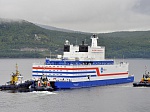30.08.2019
COMMUNICATIONS DEPARTMENT OF ROSENERGOATOM
The floating nuclear power station Akademik Lomonosov has passed its first 1000 miles on the way to Pevek
The floating nuclear power station Akademik Lomonosov, which set sail from Murmansk on August 23 being accompanied by the Dixon iceboat and two tows to its destination in the city of Pevek in Chukotka, has covered its first 1,000 miles (1,852 km) during the first week of transportation.
All in all, since the day it was towed from Murmansk, it has passed 1,126 miles (2,085 km) as of August 30, with 1,514 miles (2,803 km) remaining to Pevek. The floating nuclear power station passes around 170 miles (315 km) per day with the help of tows. The transportation to Pevek is planned to be completed around mid-September 2019. The towage goes according to the schedule.
Following its arrival at Pevek and connection to the grid, the floating power block will become a fully-fledged power facility as a part of the Floating Nuclear Heat Power Station (FNHPS). Upon its launch, the Floating Nuclear Heat Power Station will become the most northern floating NPP in the world, making the Bilibino NPP a runner-up. Besides, after its launch, the number of nuclear power plants in Russia will be increased from ten to eleven. In the future, it is supposed to replace the generating capacities of the Chaun-Bilibino load center – the Chaun CHPP in the city of Pevek and the Bilibino NPP in the city of Bilibino.
Since the floating nuclear heat and power plant is going to be located in Pevek, it will spur the social and economic development of the Chaun municipal district and Chukotka in general. Besides, the plant will become one of the key infrastructure elements within the Northern Sea Route development program as it will facilitate all-year round icebreaker support, which, in turn, will enable major logistics projects around the Pevek port, where the floating power block is going to be located.
The floating nuclear power unit (FPU) (FPU) “Akademik Lomonosov” of project 20870 is the main project of the series of mobile transportable power units of low power. It is designed to work as a part of the Floating Nuclear Thermal Power Plant (FNPP) and is of a new class of power sources on the basis of Russian technologies of nuclear shipbuilding.
The nuclear power plant has two KLT-40S reactor units that can generate up to 70 MW of electric energy and 50 Gcal/hr of heat energy during its normal operation. This is enough to keep the activity of the town populated with 100,000 people. The FPU is the unique and the world’s first project of the mobile transportable power unit of low power. It is designed for the operation at the areas of the Extreme North and the Russian Far East. Its main task is to provide the remote industrial plants, port cities, as well as the offshore gas and oil platforms with electric energy. The FNPP is designed with the great margin of safety that exceeds all possible threats and makes nuclear reactors invincible for tsunamis and other natural disasters. In addition, the nuclear processes at the floating power unit meet all requirements of the International Atomic Energy Agency (IAEA) and do not pose any threat to the environment.
The Rosenergoatom Joint-Stock Company is a leading unit of the Electric Power Division of the Rosatom State Corporation. The JSC is the largest generation company in Russia in terms of the electric power output and the world’s 2nd one in terms of the atomic generation capacity. It encompasses all 10 nuclear power plants of Russia that have an affiliate status as well as companies facilitating the operation of the generation unit. All in all, the Russian NPPs operate 35 power blocks with the total installed capacity of 29.1 GW.


 career
career Innovations
Innovations Projects
Projects INTERNATIONAL BUSINESS
INTERNATIONAL BUSINESS